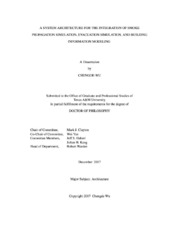| dc.description.abstract | A new software system architecture was designed to integrate smoke propagation
simulation, evacuation simulation, and Building Information Modeling (BIM). The
integrated software prototype automates the majority of the simulation workloads,
enabling seamless data _ow from BIM to smoke propagation simulation and evacuation
simulation, and thus providing architects rapid feedback in design decision process.
As the key to integrating smoke propagation with BIM, the research produced
two spatial transformation algorithms and a room selection algorithm to resolve the
incompatibility caused by the need to simplify the BIM representations for use in CFAST.
With these algorithms, smoke propagation simulation of real-world buildings can be
easily performed on a BIM model. To demonstrate the integration of smoke propagation
simulation and BIM, a software prototype was developed with Revit Architecture and
CFAST. In addition, a visualization module was developed to present simulation results,
which are usually in thousands of lines of numbers, in a visually understandable format.
A simple BIM-based multi-agent evacuation simulation model was developed to
provide architects with more informative design feedback. At each simulation step, each
agent collects the data of the surrounding environment, such as CO concentration at their
head level and room temperature. The results of the simulation can be visualized as
graphs and animations which help architects to visually identify bottlenecks and examine
the clarity of circulation design.
The validity of the algorithms was tested by FDS simulations and CFAST simulations.
The analyses of the FDS validation tests showed that the transformation algorithms
introduced 5-10% error for the majority of the test cases. A few extreme cases showed
more than 10% error. The analysis tests showed that the room selection algorithm
introduced 2-7% error.
Intensive use of the software can provide insights to a designer that may result
in new solutions to increase _re safety. A series of FDS simulations as experiments
scrutinized how ceiling design and door design affect building _re safety. The results of
the experiments showed that opening 16-25% of the ceiling can deter smoke propagation
up to 60% by holding smoke inside plenum area. | en |


